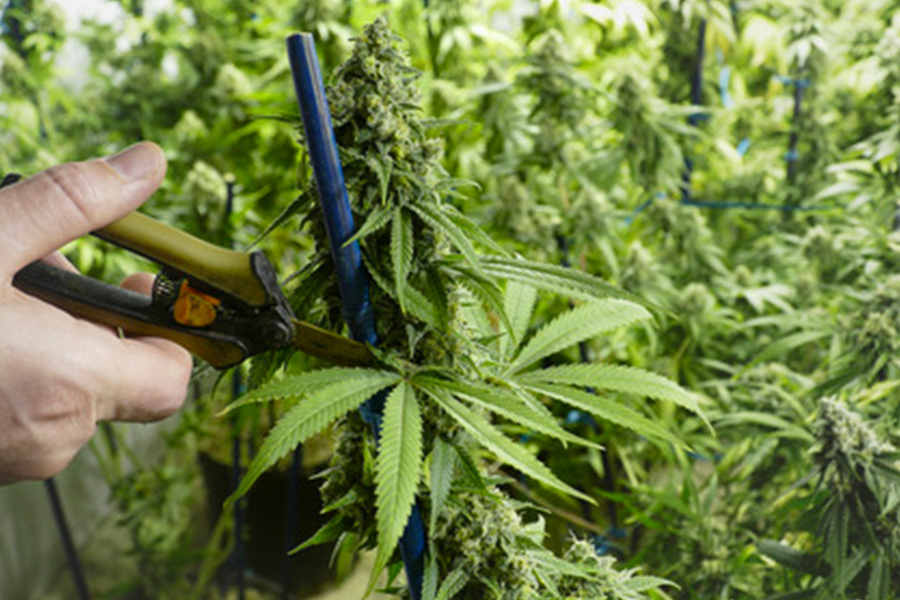Cannabis plants are renowned for their vigorous growth, especially on farms dedicated to cultivating high-quality flowers. As the plants reach midseason, a crucial practice known as pruning and de-leafing comes into play. Both techniques involve the strategic removal of branches and leaves to enhance flower development, optimize light penetration and airflow, and reduce the risk of mold. In this blog post, we will explore the significance of pruning and de-leafing, their practical applications, potential drawbacks, and the importance of genetics in achieving optimal results.
Pruning for Quality and Growth
What is pruning? Pruning is a crucial step in promoting higher-quality flowers. By selectively removing excess branches, the plant can focus its energy on the chosen few. This results in larger, denser, and more valuable buds. Typically, lower branches that receive insufficient sunlight are pruned to channel the plant’s energy and nutrients into the upper canopy. Pruning cannabis improves flower size and weight while reducing the risk of mold, which can grow in shaded areas. While pruning is less relevant for auto flower crops due to their shorter stature and quick maturation, it is an indispensable technique for full-term and semi-full-term crops.
De-leafing for Enhanced Yield and Quality
De-leafing involves the removal of fan leaves from the upper canopy of cannabis plants as they approach maturity. This process serves multiple purposes, including increasing sunlight penetration, improving airflow, and reducing the chances of mold development, especially as the crop cycle nears its end. By removing fan leaves, growers can achieve greater uniformity in maturation and potentially increase yields by 20-30% due to improved light distribution within the canopy. Additionally, de-leafing triggers a stress response in the plant, accelerating its maturation process. Furthermore, removing fan leaves before harvest eliminates the need to dry them, as they hold no value for consumers and can impact post-harvest drying efficiency.
The Labor-Intensive Nature of De-leafing
De-leafing, unlike some mechanical processes, requires a manual approach. This makes it a time-consuming and labor-intensive endeavor. For example, in an autoflower crop with our specific planting density, de-leafing can take approximately 200 hours per acre. It is essential to note that the lower stature of the plants requires bending and working at uncomfortable heights. Full-term crops, with a height of 4-6 feet and an average planting density of 3000 plants per acre, demand even more labor, averaging around 300-350 hours. As the price of cannabis flowers decreases, finding ways to reduce labor hours becomes crucial. Some farmers have turned to machine trimmers, allowing them to skip the de-leafing process entirely.
Trade-Offs and Genetic Considerations
While machine cannabis trimmers may help reduce labor costs, there are notable drawbacks to this approach. Skipping or reducing de-leafing can hurt yield and quality since light is crucial for optimizing bud size and density. Furthermore, using machine trimmers without separating flowers and leaves dilutes cannabinoid content and reduces the value of trim, making it less desirable to processors. Fan leaves left in the drying room add to the overall water content, which can disrupt airflow to the buds. This limited airflow raises the risk of mold formation during post-harvest, potentially harming the quality of the cannabis. While machine de-leafing sacrifices value and efficiency in post-harvest space, it offers a significant decrease in labor costs.
When confronted with these trade-offs, it is crucial to consider the root cause of the dilemma. Selecting cannabis varieties with a low leaf mass becomes paramount in preparing for the industry’s future, where price compression will play a significant role. Understanding the genetic requirements and consulting seed purveyors or nurseries can provide valuable insights into the extent of pruning and de-leafing needed for each specific variety.
Pruning and de-leafing are key techniques in cannabis cultivation. They help growers improve flower quality, boost yield, and reduce mold risks. While labor-intensive, these practices yield significant benefits in terms of plant health and overall crop value. Balancing the trade-offs between manual de-leafing and machine trimming requires careful consideration of desired outcomes, genetics, and the evolving dynamics of the cannabis industry. By adopting strategic pruning and de-leafing approaches and selecting appropriate genetics, cultivators can navigate the challenges of a price-sensitive market while delivering exceptional cannabis products.
